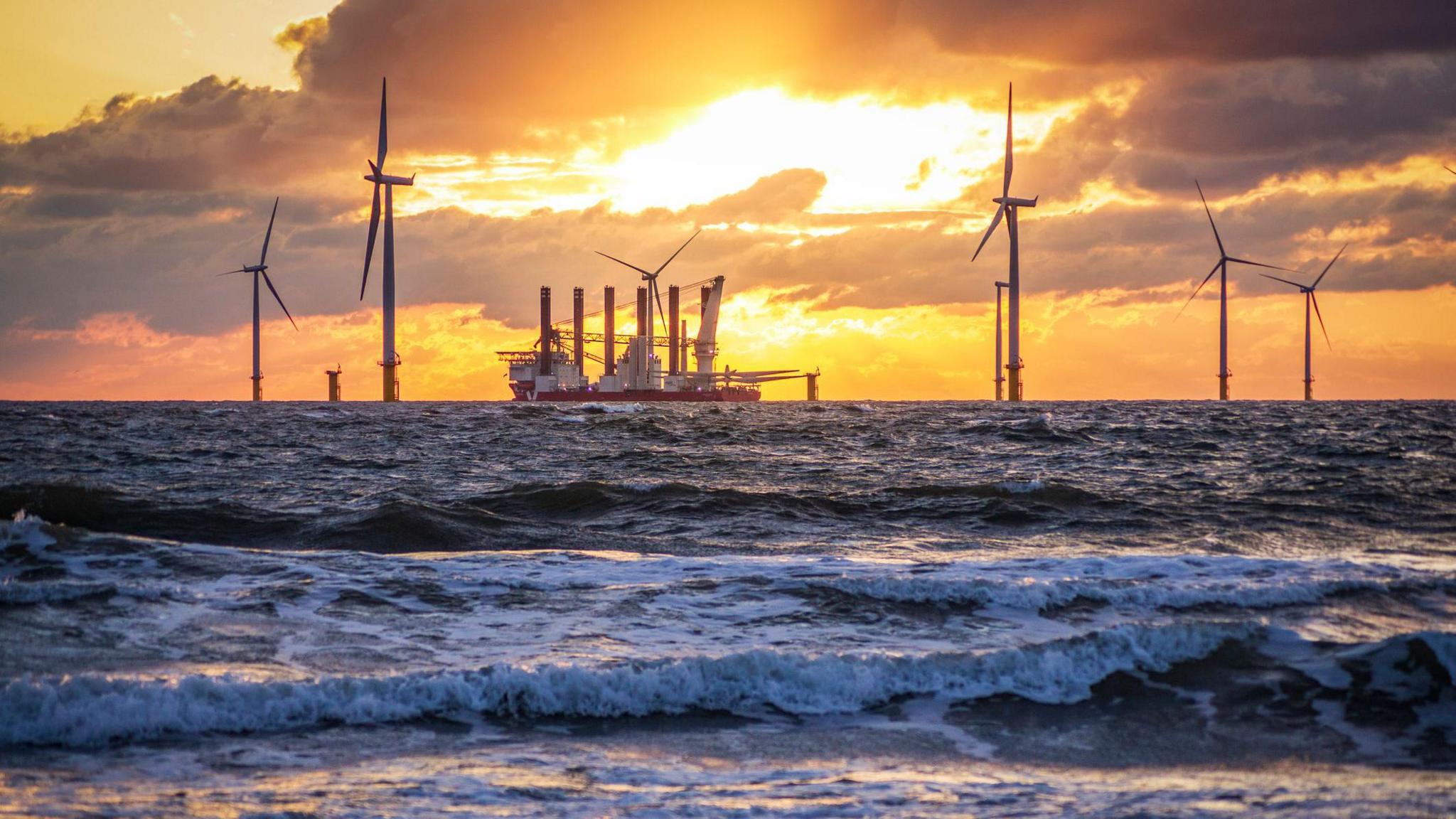The choppy waters between North Sea oil and green energy revolution

There is concern over the pace of transition for oil and gas workers into the renewables sector
- Published
The Great Energy Transition is under way, and may come to define this era, but it's not going smoothly.
For the oil and gas sector, a further sign of its decline - both long-term and cyclical - is in 250 onshore Aberdeen jobs being axed by Harbour Energy, now one of the biggest operators.
With a global portfolio of producing fields, it has other places to put its capital, from Egypt to Argentina, where profits are not taxed at 78%, and where the government is not refusing to grant new drilling licences.
It is also reviewing its commitment to the Viking carbon capture and storage scheme being planned for Humberside, blaming "repeated delays" by the UK government.
Oil and gas firm plans to cut 250 jobs in Aberdeen
- Published7 May
Blow to clean energy drive as major windfarm ditched
- Published7 May
Major hydro power plant expansion put on hold
- Published7 May
The same company is a partner in the similar Acorn project, based in north-east Scotland. Those "repeated delays" affect both projects.
It would be less concerning if there were a transition for oil and gas workers into the renewables sector, re-skilling as they move. For many, including their union representatives, that is merely rhetoric.
And the gap between one industry declining and the other rising is growing wider, with the decision by Ørsted, a Danish company, to halt development of a vast offshore wind farm off the coast of Yorkshire, called Hornsea 4.
The project secured a valuable and hard-won guarantee of a minimum price for 15 years, known as a Contract for Difference. That reduces risk for investors. But Orsted, majority owned by the Copenhagen government, is giving that away, and paying heavily to break supply chain contracts, because the financing of the project no longer stacks up.
The clean energy revolution is also grinding to a halt near Scotland's west coast. Drax, the owner of the hydro power station inside Ben Cruachan near Oban, had plans to expand its potential for pumped storage - a form of storing power by pumping water uphill when demand is low and there's excess supply of wind power, and then releasing water steeply downhill to generate power when demand goes up.
To reduce risk for investors, it wanted to win a similar type of contract for a minimum price (as well as a maximum one). But it's decided to postpone that £500m plan, blaming the capital costs.

Some high-profile offshore wind farm projects have been halted or scrapped
Even before the auction of contracts has been designed by Ofgem, it's backing out of bidding later this year, looking instead to the UK government and its regulator, Ofgem, to help reduce the risk and the costs associated with it.
Meanwhile, Drax is looking at less ambitious options for expanding the existing power station, now aged 60, which could generate both power and the cash to go much further.
Such delays put a big question mark over the Labour UK government plan to reach 95% of British energy generation from clean sources within only five years. If current plans cannot stack up financially, there are many other plans that are put into doubt.
These include four projects for pumped storage in Scotland - three of them new, one an expansion - and the humongous ScotWind plans to locate hundreds of fixed and floating wind turbines arrayed around the coast of Scotland.
Without pumped storage, the greener grid will require a lot more battery storage, and that is not proving popular with those who live near planned sites.
Because the UK government has set such an ambitious and high-profile target for clean, green power, it may be that these developers are using the leverage of a halted project to get a more attractive set of price guarantees.
These don't come from the taxpayer but from future electricity bill-payers, and Ofgem has the job of balancing the consumer interest with the objective of the energy transition.
It may also be that Harbour Energy is backing up the wider oil and gas industry in putting pressure on the UK government to give it a less hostile business environment. It took only a few minutes from the announcement of Harbour's job losses to Prime Minister's Questions, with both the Conservatives and SNP piling on the pressure.
Zonal pricing over national pricing
Across the British energy sector, this pressure is building at a vital time for three difficult and complex decisions.
ONE. The UK government recently closed a consultation on the future of the oil and gas industry, the way it is taxed and licensed.
The industry has been lobbying furiously for a slower wind-down of drilling activity, arguing that Britain will continue to need oil and gas for decades, and it is more secure and less damaging in greenhouse gas emissions if that is domestically produced.
To concede that argument would be an awkward U-turn, particularly for the Energy and Net Zero Secretary, Ed Miliband. Not to concede it puts future job losses at his door.
TWO. REMA, the Review of Energy Market Arrangements, is a Whitehall project to change the way markets work. The big decision there is over zonal pricing, instead of a national pricing system.
The case is made, most enthusiastically by retail supplier Octopus, that it could cut prices in some parts of Britain if they reflected the market rate for regional supply. So lots of wind power in northern Scotland could mean cheaper prices for northern Scots.
That is in theory. Critics of the plan say it would add cost overall, prices would be more volatile and unpredictable, which is itself a cost to suppliers, and cheaper power in one part of Britain would likely mean higher prices in other parts.
Developers of renewable energy say such a change would render it hard to make an investment case, where revenues become even more uncertain. And bedding in the system could take until the mid-2030s, and delay progress on other priorities.
An alternative outcome from REMA would be an evolved system with several reforms:
Technical and economic fixes to balance the power grid when the wind doesn't blow, and reduce the dependence on back-up gas plants
Opening up access to smaller generators, in solar, for instance: improving price transparency
And reform of those Contracts for Difference to align them with the changes the power system needs, and not merely with lower prices for consumers.
The intention is to send signals to investors that they can have the confidence to commit an estimated £40bn per year to fund the energy transition. Ed Miliband is expected to make that decision this month and announce it next month.

Keeping domestic energy bills down could come at a cost of securing jobs
To back up that confidence for investors, the taxpayer-fuelled National Wealth Fund has added to a busy Wednesday of energy sector developments by committing £600m, alongside Bank of America, three Spanish, one French and two UK banks, to complete a £1.3bn Scottish Power loan.
This is for the Glasgow-based, Spanish-owned utility to build some of the grid connections necessary to link renewable power with customers. The total GB bill for that, however, looks more like £60bn.
In this case, it contributes to two high-voltage subsea links - one from Torness in East Lothian to County Durham, the other from Fife to landfall in Lincolnshire and on to Norfolk, while installing new substations and overhead transmission cables, often facing the headwind of local resident opposition.
And then there's THREE. Ofgem is due to conclude a review of the costs to developers of having access to the national grid. Known as TNUoS, Transmission Network Use of System, this has long been controversial in Scotland, because it places a rising cost on generating firms per unit of power as you travel north.
This was designed more than 30 years ago, as an incentive to build big thermal power stations nearer cities.
In the north of Scotland, where the most reliable winds blow, there's a hefty cost. In the south of England and Wales, connection is not a cost, but a subsidy. SSE Networks, which owns and operates the north of Scotland transmission cabling, is lobbying for change and gives an example of similar wind farms, the northern Scottish one paying £5.54 to connect per megawatt hour, while a Welsh one receives £2.81 in subsidy.
What about Net Zero targets?
Added to very high volatility from year to year, this issue is a deal-breaker for the next generation of offshore windfarms. Their supply costs of installation have been rising steeply, so they want to nail down the continuing transmission costs and the revenue they can expect.
That's put Ofgem under pressure to change the system, and build in incentives to put turbines where the wind blows.
None of these decisions can be spotted on your domestic or business energy bills. But all of them end up there, embedded in the prices charged for getting power into homes and business premises.
As more money is spent and the transition continues, a larger share of the bill is likely to come from the costs of giving developers and financiers the incentives to invest.
Such costs could be avoided, if the priority is to keep bills to a minimum. But that comes at a price, of jobs not created.
The power grid would remain dependent on imported gas, and on the volatility of its global pricing.
And the targets for Net Zero? Blown away.